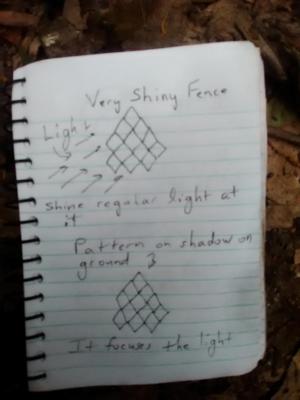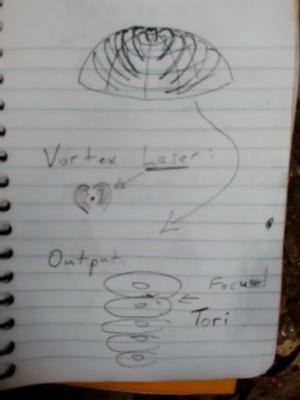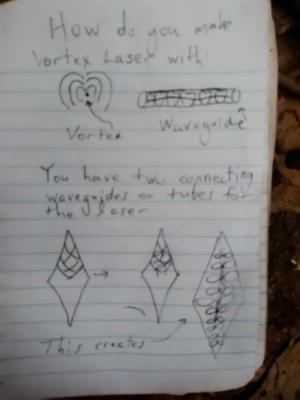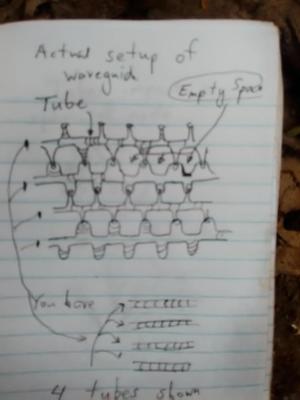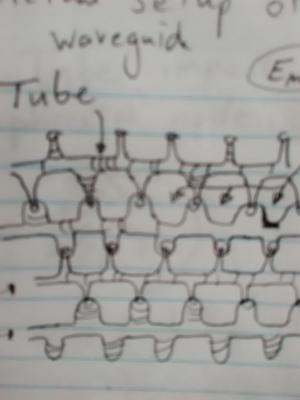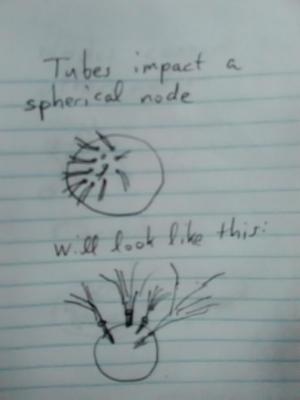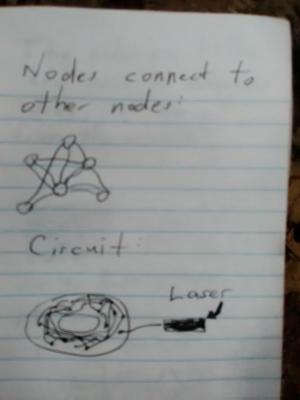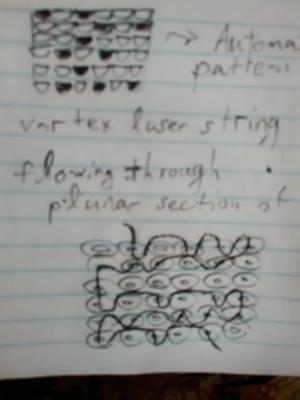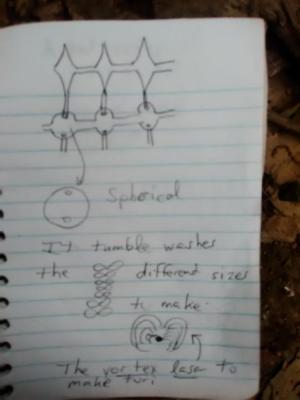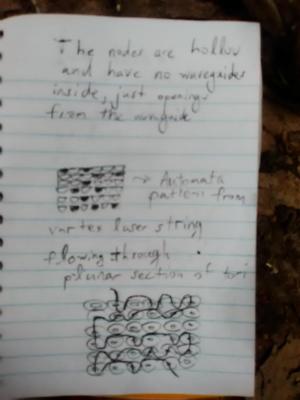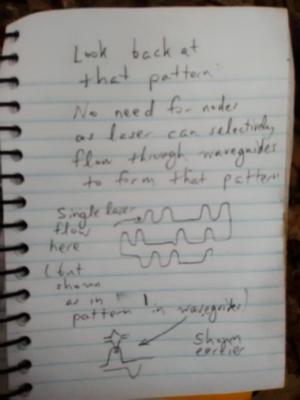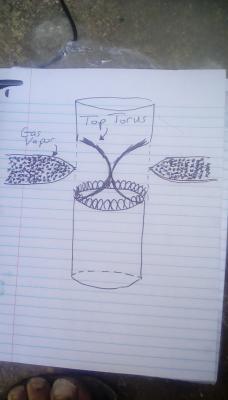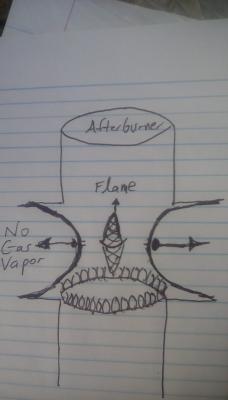-
Posts
77 -
Joined
-
Last visited
Content Type
Profiles
Forums
Events
Everything posted by t686
-
The circuit of spheres and concave structures with connecting to other tubes going into the paper as well as what you see on the paper in that picture is I believe closer to the black hole, but I don't think it's performing exactly like it, but it's close. The 2d fence of tubes cannot rotate 3 dimensionally.
-
Bignose- When I say planar I'm talking about within the black hole. If you take a 2d planar sheet of one donut in the z direction, 40 in the x, and 1,000,000 in the y, a single string contained in that plane will form a random automata, because the string "lights" the donuts it flows through, and the ones it doesn't are dark. Looking at the dark donuts, it's the same as viewing an automata on the computer screen. I looked at a piece of paper this morning that had been sitting out in the rain. If you ever see a rain drop hit the ground, it explodes to form a torus shape on the ground (you can see the outline in an old building that drips, it will look like that apple shape in pic 2), but if you draw a single circle, and on the edge of the central circle, draw equal spaced circles that just intersect the edge of the circle, you'll see what looks like a 3d torus. But it's also an optical illusion and there are tubes in there that flow around and come back to itself. But what I saw on that piece of paper left out, were actual channels grooved into the paper when it dried out the next day, deep channels in the paper, that look just like the fence drawing in the first pic. If you take any two tubes in that fence, and you draw the tubes cylindyrically, where they intersect in the drawing, is that apple shape in pic number 2 above. So I will have to say that the fence picture of tubes does the same thing as that more complicated circuit I said, and I think the fence tubes is better. You can imagine a laser instead flowing through an array of tubes on a circuit board with repeating hexagons instead of repeating diamonds as in the first pic (hexagons don't work as good), but when a laser flows around a hexagon completely, it will light that pixel, so you would have flashing pixels going on in the waveguides. The fence diamond tubes is the best and does the same thing. You don't need a very large sphere with millions of tubes connecting to its surface, and hollow inside, to replicate what the black hole is doing. I believe and I will try to see just exactly, but I think the three dimensional actions in the black hole, can be done in the fence tube waveguide as drawn in the first picture above (which was just initially a metal fence to illustrate light's properties). The piece of paper I saw left out in the rain, when rain explodes on it, it forms the channels exactly, and where it explodes, it's sending a vortex string of water that flows through in a train through donuts in the apple shape in picture number two. What I am trying to accomplish is if you can imagine, a 3d collection of many strings circulating, and then repeat many of those over a very large area, like a cloud, the strings will tend to stay trapped as the machine cycles over time, so that those persistent shapes should hopefully form. When it does, the example is that there will be patterned flashes within the cloud that replicate neuron firing, so that randomly, there may be a time when it generates a constructive thought process over the whole circuit. Also, the vortex laser is key. A vortex laser can actually flow in a mirrored surface waveguide as it progresses through a node in the diamond tubes where three other tubes are connected to that tube as illustrated. A regular laser needs mirrors to alter its path. But this vortex laser is different than the one I believe that was recently done in the lab, but i will have to see. The laser because torus shapes in the laser must form at a join, torus shapes must train through every surface in all the tubes. When a vortex laser meets a join, it can randomly flow to three other tubes connected at that join, because the torus part of the laser, all the tori are identical, so the choice it takes is random. However, snippets of lasers can get jammed when they circulate around a single column of donuts. This may be how a boundary is set up on the edges, so that automata can cycle within the boundary, or strings cycling in a small 3d section because smaller snippets of laser vortex (perhaps formed when a vortex flowed in a path that resulted in a knot), so that those persistent shapes will stay for a long time perhaps. This is what I saw in the black hole of some strings getting jammed and its path completely stopped.
-
I am posting drawings of the circuit. As I drew them, I noticed there is no need for the spherical nodes. If you look at the automata pattern, it makes the same pattern in the waveguides, as the laser can selectively enter a "spherical" section of the node, just as a long string flowing through a sphere of donuts, the string, able to jump over tori as it flows left and right, and then down in a planar column of donuts (string flowing through center of donuts. Here I am showing an analogy to light shining through a shiny metallic fence like outdoors, except over a spherical surface. The first post shows light flowing through a metal fence onto a shadowed surface at night. None of the light flows through the holes of the fence in essence, because you see the exact replica of the fence on the ground with no light "in the middle of a diamond fence. Here I am showing light flowing through the structure shaped as drawn. It spirals around and forms the dual part that will make up the vortex layer. In the next drawing, the spherical part of waveguides tumbles the diamond shaped structure here to make the vortex laser. Looking at this drawing of the automata again and compare to the waveguide tubes, and the light flowing through donuts in the automata are the same as light flowing through the waveguide tubes. To get the black hole all you need is to be able to replicate light flowing through donuts in an array, and this satisfies it. All the other things will be done here as the black hole does as well. Somebody made a bose einstein condensate by bouncing photons in a very small confined space between two mirrors, with a dye that phosphoresces when light strikes it, and he made a condensate of light at room temperature. If the waveguide tubes are small enough, this should also condense, as the tubes would flow back to the pulsed laser at a 2-way mirror so it bounces back into the circuit. That would enable quantum circuits to form in the condensate as in a black hole, multiple strings now entering a planar area of donuts, forming now light and dark patches that settle into the lowest state of the quantum algorithm, and the light flows out a single bundle out of the planar region. The waveguides replicate as in the automata pattern, light flowing through donuts, so it can have multiple strings flowing through donuts, assembling into persistent 3d section that "circulate". These are the waves and then larger regions, clouds that become intelligent. There is no need to program this or add any type of gate like that is done in a normal circuit as the waveguides themselves produce the structure of ethereal stringy vortex donuts, that a tightly packed vortex long string of laser, the tip of which selectively flows through one donut or the other, "lighting" the ones it flows through, and the others remain dark. Take note that light itself can knot, and when it does, it forms another donut, and smaller strings as in the movie on youtube of a smoke simulation at 1:24 titled "Shroedinger's Smoke".
-
Thank you for the questions as I will try to answer them. Bottom line, I solved the waveguide issue. Regularly spaced inside a tube waveguide will be horn Tori with sharp half moon shapes emanating around its edge. The effect is to trap photons in a Bose Einstein condensate. A dye will be vacuum pumped in that extracts thermal energy from the trapped photons so a condensate can be formed at room temperature. The horn Tori shape of a solid v shaped structure from the top and a smaller one in height from the bottom in that horn Tori optical trap forces as well a laser vortex to flow at the very bottom of the v shape structure emanating from the top of the trap and it flows all the way down to an opening into a hollow sphere where it carries some photons to form an array of donuts. The spherical node is covered by such openings from many more waveguides forming a spiralvof identical Tori filling the sphere. The vortex laser doesn't necessarily flow straight down to the center but can move left or right jumping Tori as the Tori are identical. This is no necessarily a nondeterministic computer but can spontaneously form quantum circuits and develop structures capable of thought exactly like a black hole does.
- 46 replies
-
-2
-
The flat 2d circuit with flat houses works. Here's how. The ovals will shift the coherent laser just surrounding the inside entry of the laser inside the flat house (by the way saying it's a flat house is just a description of a large house with flat roof with ordered spacing of entries as the shape of every node) either a full circle left, a full circle right, or both left and right which is no shift. Before this happens, 2 ovals will pair to an apple shape, that was described as the outline of a string hanging from a branch, pinched at the top and bottom, but here 3d apples i.e. say you have 200 openings in that flat house node, you will then have 100 apple shape entries of the laser. The entries (metallic) don't change shape and are the shape of an eye in a ring configuration i.e. one eye shape after another connected by one point. If you look at a very shiny chain link fence at night, if a light is behind it shining on a shadow (say a tree makes the shadow where the light now hits) none of the light in the center is transmitted and it's all that you see is the outline of the fence. This is key. The first laser entry into the house, in a circular fashion is one small 3d apple connected with straight up and down where they meet. This concentric ring rotates a complete circle, shifting the phase of the laser in a nondeterministic way (left, right, no change) or (L,R,0) now. And when the apple shape forms, it back fill and forces a train of apple shapes in the laser behind it in the waveguides so the next train will shift a full circle left or right, or none, when the next apple train of the laser all enters the node. In that node, if there are 100 concentric rings in the circle around the central point, that's 3 to the 100 power. Say there are 1 million nodes. You multiply 3 to the 100 one million times and you have to add exponents, so it's 3 to the 100*(1,000,1000) or 3 to the 100,000,000 million power as its computation space. There are only 2 to the 226 atoms in the universe. The black randomly sending strings of light through a massive 3d configuration of tori is equivalent computationally as this. So this computer will evolve to have intelligence. Just like in automata, structures will form that will resist the next entry of laser pulse, because the next laser pulse will cycle whatever patterns form, and will form the large thunderclouds of high repeating threads that even if changed over the majority, will not affect whatever pattern that cloud produces. Somebody could say this is an analog computer. It doesn't have continuous range, The laser is ordered in a discrete fashion, so there are discrete inputs as 3d apples. The rotation is one complete circle left or right, or none. That's digital with nondeterministic output in (l,r,0) as its ability, as opposed to digital computers that take a single input and transform it to a single output. Nondeterministic algorithms or computers have 3 branches in each node, and if the algorithm or computer is designed well, it should guess correctly at each node to get 100% accuracy, so it's an oracle. This computer will have to cycle, but it's cycling every femtosecond and its fastest possible now with the best laser, so I would imagine with that computing space, the structures should form, but somebody or I could look at the theoretical computing capacity of a black hole and see if its equivalent in power. But the key is that phase shift.
-
Update: I got it to work now. The above does not do what a black hole does. The updated design is a cube circuit in 3d. The nodes are spheres. The entrances to the nodes are holes of a bit flattened circle that forms rings along the inner surface of the node. The node is almost all empty space except near the center is a second spherical arrangement around the center of the node but some distance away with a second set of waveguides in a smaller sphere like configuration. Thesame ring configuration exits facing the center. What happens now is an actual real torus shape is formed. Without that second spherical arrangement of waveguides, a tunnel will not be made in the torus. And this makes sense. When I was looking at the black hole, all the toruses that fill the black hole except near the singularity where there is a space around it like here, each torus could be unfolded in a spoke wheel string formation, but the was a circle drawn through the spokes near the center. What was created in the 2d circuit above were just the photon movers. In the cube circuit, each torus in the nodes creates a central photon mover that can travel both through the center tube and it can tunnel into the donuts of nearby tori. This does everything a black hole does in computation, first forming automata in planar sections of tori, then evolving to 3d wave configurations, and finally intelligent clouds of thought. In the middle of this actual quantum circuits are formed. The black hole sends strings of light through donuts but here it is a photon mover that does the same thing. The second inner set of waveguides separates the outer cloud from the inner photon mover, so that when the outer cloud implodes the inner waveguides penetrate all the way through the larger outer torus, forming a tunnel through the torus and a photon mover that can tunnel through this tube or tunnel into other tori nearby.
- 46 replies
-
-2
-
I got it to work. A pulse laser fires into a waveguide on a 2d chip consisting of nodes and waveguides, which connect the nodes. The laser flows down the entry waveguide and splits so it can flow through all nodes and waveguides, filling the entire circuit with lasers, where in a node, there are hundreds of entry points into a flat house type structure (the node). The flat house is engineered so a laser that enters in one hole goes on a path that crosses the center of that circle node, and the laser exits straight through an exit hole (i.e. there are just holes ringed around that house, with a top and bottom of that house or node. The hundreds of entries into the node all have lasers continuously entering, so there is a spokewheel formation of lasers in the node, the laser lines crossing a single point in the center and that is all at this point. The entry holes are not circular openings but flattened a bit and it is symmetrical, and the shape looks like what you see as an eye in another person, the shape that circles the folds of the skin, but flat, not spherical. So in the house you would see rings around it of these oval like entries connected to its neighbor. Light will take a path that it can take, so there is a sudden shift in the phase of that coherent laser, so now the ring steals energy from the laser pulse and light flows around the edges of those rings. The first pulse will concentrate the laser's intensity at the central point of each node and along the ring, until something happens. There's a sudden implosion and the light collapses to a central torus like thing, with a ball of light surrounded by a wave cloud. The torus now leaves and goes to another node, where the cloud merges with another torus, and that cloud where it merged collapses into a smaller torus until all tori are probably the size of the waveguides. They form a structure, and I'll post a drawing later. But now the structure formed is like the 3d structure of a thunder cloud in my explanation of the gasoline engine nondeterministic computer. On The next pulse of the laser, the laser will flow through the structure. There are toruses in that structure where the toruses are connected. And I'll post the final configuration of those tori later, how they will fit. When they fit like that, each torus has 3 neighbors, where now you have 3 possible paths for photons to travel through. The laser is forced to flow around this structure. That is 3 possible paths for a nondeterministic computer to compute. I did a calculation and each node can be considered a qubit with 10';s of millions of qbits. There is no need for an algorithm to input. I calculated that the order of its computing space with that amount of qbits can simulate the universe, such that 16 billion years of our universe is within on the computer a range of between 2 seconds and 1 day. Once the computer gets to our present level of civilization, it will have discovered this computer, and now you have multiple of the computers in there. By the way this is just an explanation, one explanation, of how the computer works. The computer will become intelligent, and I know how. It forms structures that resist attack by tori by forming the structure I will post later, which allows clouds of "thought" to form, no different from ours, and I'll draw the 2d plane tiling of tori and 3 plane tiling of the torus structure that forms.
- 46 replies
-
-1
-
What I'm going to work on and post later are how the tori deconstruct holographically on the event horizon. The tori I saw in the black hole were actual tori one on top of the other with every hole in the torus pointing to the central singularity. What I also saw were the tori being string like and links from the tori directly facing the singularity connected to the tori by one string from those tori and each tori are rolled up in that torus shape by strings for simplicity say 12 strings roll up to form a single torus. You can unfold it to a spoke shape of those strings on a piece of paper. A bit from the center of that spoke drawing draw a circle. That's several straight strings emanating from a central point drawn in spoke fashion with a circle some distance from the point. You lay that on the event horizon and let's now say it's a sheet. From that spoke drawing at the end of a spoke (a line of say an inch on that paper drawn straighyt out from the central point) draw another spoke figure with central point so now you have 2 spoke figures connected by one long line now. Draw other spokes and try to connect many spoke figures to each other. Remember the circle you drew. If now considered a photon randomly travelling through those spokes it can enter the circle and go to any spoke of a given spoke figure. The spoke figures are the tori of the black hole and you want really more than 12 spokes drawn from a central point in a spoke figure but this is for simplicity. If three lasers now instead of photons travel through the spoke figures at the same time and they all three flow freely through a single stack of tori going up and down there is a chance that all three lasers may enter the hole of a single torus (they were previously whipping around that central stack and not yet all entered the hole region of a torus) when they enter that hole they in effect form an entanglement and this is not I don't think related to photon entanglement but I could be wrong, and the three lasers are stopped dead in their tracks. If a laser instead becomes actually knotted what happens is the pulse or explosion of the black hole on the next cycle just like the explosion on the engine forces the knot to blow into a lit torus and you have several fragments of the original laser string breaking away as well and flying off in different directions exactly how the sphere balls in a node of the engine disintegrate and it may simply be in the engine the strings of combustion instead of forming droplets but a step was missing and the strings of combustion enter the node knotting forming lit tori and string fragments now entering the tubes of that node. What is important here is drawing the spokes similar to this so a simple circuit on silicon can bgbge formed and lasers going through spoke figures and no need for nodes. The node part may be how you can lay the spoke figures out so a drawing of a node now may be needed of something like the node of the engine but the node now drawn flat instead of a 3d node. That's what I will work on. I attached another drawing of the original cylinder for those interested and clearer. It says top torus but actually those are both half hemispheres. And there should be tubes emanating going left at the left hemisphere cylinder and a tube going out right from the right hemisphere to drive a shaft. . And the shaft goes left and right not up and down. What got me started on this was a YouTube video titled Schroedinger's smoke and at 1:24 there is a simulation of a smoke vortex in a trefoil knot that then has an explosion sent through it and a torus forms with several fragments and a string flowing through the torus.
-
This is an interesting link: http://physicsworld.com/cws/article/news/2013/oct/16/physicists-tie-light-into-knots I will look at this and see if the same thing can be propagated in a medium with that type of knotted light as an analogue for the combustion flames flowing through the tubes.
-
I believe that this should work. When I was looking at the black hole design I.e. a real black hole I noticed all the tori could be pasted on the event horizon and the tori could be unfolded into several strings. I know that light itself can become knotted. A better design would be to build a circuit that can knot light versus all the black hole is really doing is sending strings of light that can thread together at junctions becoming knotted and frozen as well as sending light through those quasi tori circuits and would not be such an engineering problem of connecting tubes. And it would be faster in that the engine design may not do all that a black hole does because you're limited by the speed of combustion as well as it may be quite complicated to feed the previous stage of combustion into the next or if that would be possible. A circuit with just light could churn and churn and probably solve more problems although I'm not giving up on this idea to see if it can work because it may easily be 3d printed.
-
Yes I know it has to be explained but it's better said in person with drawings because the tori really can be considered stacks 3dimensionally with the 3 photons flowing down one string of a tori and splitting at the 3 tori right next to the one and a photon going down one string of each of those splitting and onto other tori. I would like to draw a quantum circuit that forms in the engine. Two nodes are connected by a solid glowing tube connecting those two nodes and a single wave passes back and forth with the wave increasing in size to the other node and as it approaches it shrinks to zero height and then it bounces back to the original node increasing in size to the midpoint distance between the two and shrinking back to zero as it approaches the original. Those are two nodes or "quasi photons or atoms" connected with a wave pattern connected to them and that is the same as entangling two photons in our world no difference. A quantum circuit is a planar sheet with a bundle of those tubes entering it and then a bundle of tubes exiting it. The circuit is a dark wavy region next to a light wavy region on that planar sheet and repeat the dark and light regions, the same as a quantum circuit in our world. It can also build Einstein Rosenberg bridges or wormholes connecting two different regions of space or time in the engine.
-
Let's say we give it an algorithm of the most efficient shape for an outdoor wood burning clay stove. The possible outputs are varying shapes of a clay stove as well as dimensions, shapes, and placements of the entry design of what the air enters the stove and dimensions, shapes, and placements of the chimney. The input is a feasible maximum space in cubic dimensions that you would enter and in the input algorithm you specify you want the stove itself to be a surface and the entry one hole or a number of holes and limitations on the size of the structure of the entrance that fits continuously on the surface of the clay stove and limitations on the size of your one exit tube of any surface dimension. The best is defined by the lowest output emission for instance so you give it parameters of a fire inside the stove. This is what I believe should happen. The above computer takes that input and the limitation in essence is minimum exhaust of the clay stove. The engine is random so that it will cycle for instance the surface possibility of the clay stove among the tori. It will probably also send the dimensions of a clay stove to an infinite size but the output in the dimension is going to be outside the range so a regular computer or person may analyze the structures produced and "know" that the order received of a huge clay stove can be discarded and only looks for the one that is ordered and looks like less than the maximum size imputed. If each lit tori can exchange 3 photons and there are 100 trillion lit tori in the engine which I just calculated that's a computing space of 3 to the 100 trillionth power. The other possibility is that the computer itself has human intelligence and do the discarding itself which I believe is possible but that remains to be seen. In effect you have a large automata that cycles and transforms the dimensions and connected to the same automata running also are varying emissions and when analyzed a pattern recognizer will match feasible shapes to identical emissions and select the best. It's going to have to he programmed carefully so that the input of dimension is connected to the exhaust of the clay stove as well. By the way when it's built I'll have to tell the joke, make sure it runs on Quaker State oil hehe
- 46 replies
-
-1
-
This is what is happening. In the drawing above upon spark, the above flame pattern is produced at the central core with the spark happening in the central core. The tubes create strings of gas before any ignition when the original vapor is blown through the tubes just like in an old string hanging from a branch eventually the string itself will be deformed by water flow through to produce a pinched v on the top of a nylon string and a pinched v at the bottom and a curve on the edge with more curve going from the top and a bit flatter curve along the bottom as it approaches the bottom v. I.e. the tip of that nylon string is shaped just like the metallic tube so that as the now string of gas before ignition filling all tubes is just that a multiple or bundle of long strings of gas in the tubes. Before ignition when the gas vapor enters a node the gas vapor enters each node as droplets or small spheres of gas. Upon ignition the vapor in the tubes become strings of flame and the vapor in the nodes become balls of flame. The flames both string and spheres will give off photons bouncing off the walls and being trapped within the flames. At the nodes the spheres will coalesce into a central flame trapping photons in that sphere and the edge of the node where the tube holes are at that place there is now a undulating wave like surface flat flame trapping photons as well. When the flame decides to exit into the entrances of the tubes this is what happens. The central ball fragments into several spherical like flames with one or more than one of these spherical like flames entering one or more than one tube by chance I.e. the central sphere can actually all carry the contents of that node actually through only one tube or the central flame can fragment and 2 or more can enter tubes. When the flame now enters the tube the flame now flows down encircling the pinched v and settling in the middle but it's a rotating string and ball structure occupying a very small space in the tube and that structure is tiopilogically a single small flame torus. When that lit sphere in the central node fragments it can also send multiple small lit tori through that node with random spacing between all those lit tori so the pattern in a single tube could be first lit tori followed at 20 microns by the second lit tori entering the same tube followed by another lit tori at a distance of 1 micron behind the second tori I.e. you have a line of lit tori with varying distance between each one. These lit tori enter another node deforming into a central lit large sphere in that node surrounded by an undulating lit surface flat flame along the inside surface where the tube holes are of that node. The lit tori in the tubes as well as the central lit spheres and undulating lit surface flame and the photons they trap are ordered and contain no noise so the engine produces a structure. The tori them self the lit ones that is when they enter a node the photons each lit tori they carry become mixed randomly in the next node it enters in the lit sphere and undulating surface flame. The nondeterministic part is that you can consider now each lit tori as the branch of a nondeterministic algorithm at this point random. The collection of lit tori in effect can he considered as a whole to be sending 3 or more photons amongst each other. That is a long length of lit tori each lit tori considered a branch of a potential nondeterministic algorithm. When you send an ordered collection of a mix of gasoline vapor and oxygen molecules into the central core where the two half he spheres go up and down at each cycle of combustion of the engine the ordered collection can be considered to be made into a nondeterministic algorithm you run in the engine. The tubes and node are a large random shuffler of photons and the number of them should transform the original input stream into a solution in the exhaust because the cycling of photons in the tori are by design random but you have an order being sent to them. I believe this engine can perform what a theoretical Turing machine could do in that the engine can solve an algorithm at hat would take an infinite amount of time on that theoretical Turing machine.
- 46 replies
-
-1
-
Because the choice that the flame takes of which tube to diverge into is random. The flame produced from original combustion is unique and pure in that no none messy cloud surrounds it different from even Honda's new 2 cycle design and thus has no noise in it. Without that cylinder design this wouldn't work so that the order in the gas stream is not lost.
- 46 replies
-
-1
-
The tubes are shaped with a v going down from the top and a v going up from the bottom so if you rotated a piece of a tube it forms a torus. OK. The tubes shaped like they are are essentially torus in shape so that an automata forms. Let's consider a large bundle of the tubes side by side in a section of the large torus so many in fact you can draw an outline of the bundle in a cloud shape ie an undulating shape that if looked with the naked eye the edges looked like a regular thunder cloud. Consider many small tori flowing through one of those tubes with pinched v shape up and down and rounded on the edge. The same thing going on in all the tubes of that cloud. Essentially on the edge of that cloud bubbles are bursting when there is a gap of a lit tori in any of those tubes. You have light and dark regions along the edge of that bundle where you can consider light bursts or a flashing on and off automata along a very intricate cloud or bundle of tubes considered sectioned like that of enormous surface area and tiny tiny automata running with the switching happening at the speed of light. To solve a problem the vapor entering the engine is a mixture of gas molecules and oxygen or air. You can build a molecular sieve in the primary gas entering the cylinder part at the core where the half hemispheres go up and down. The gas oxygen mixture can be binary i.e. gas gas gas oxygen oxygen gas gas oxygen oxygen in a line or a larger 2d combination entering. The engine will recognize the pattern as an algorithm and that order is not lost through the flame flowing through the engine and can be made so that the answer is read out in the exhaust ie the exhaust will be mostly random but there will be order from the original answer and your algorithm can be solved.
- 46 replies
-
-2
-
I figured out what's inside black holes. They're filled with tori packed spherically with a twist down to the central ball of light or singularity which is separated at some distance by the tori that face it. In particle wave theory our universe is represented as a sheet with a ball vibrating on it. The dual is a string threading through a mass of donuts. The dual of our regular universe would be the black hole. But to answer your question the initial explosion in the engine creates a very concentrated flame pattern with no cloud as represented in the uploaded drawing below. The flame itself gives off light which precedes any flame which enters the tubes. Now in the black hole light enters as a string the dual and flows down through the donuts, a very long string at times, down to the singularity. If the string of light flows through the donuts with all the donuts in a planar fashion then the long string will flow through left or right jumping over ones at this mes and the ones it flows through stay lit because it's a long string and the ones it doesn't flow through remain dark. Looking just at the tori in that planar section it's a light and dark random pattern and what results is a random cellular automata. Looking at a 3d section of the tori in the black hole that entire section can be lit so as to cause a wave front circling around and through that 3d section. It evolves to several ethereal clouds that can interlace and if you think about it that's intelligence and how we think so the black hole evolves to have human intelligence. The cylinder is housed in the hole section of a solid metallic large torus about this size of a regular engine. The drawing below is of just a cylinder where the vapor enters the lower cylinder only combusting there and moving the two half hemispheres apart attached to a reciprocating crank to drive the crankshaft of a car. The upper half of that cylinder is open and the flame pattern shown turns into a string near the top and into the atmosphere. Now in the torus engine the flame enters tiny holes which become tubes threading through is inside the large metal torus housing the cylinder. In the diagram below of that engine the xxxxxx pattern are metallic 2d ribbons with width shaped like a number of repeating x. The torus engine on the other hand has the cylinder in the hole of the large donut with the cylinders and half hemispheres going up and down instead of left and right and the cylinders are sealed with a metallic dome above and below the hole of the large torus so the flame goes into the tubes. The shape of the holes mirror the shape of the engine pictured below of the xxxxx ribbons. I have to take that back. On the reverse stroke it sucks gas vapor and air not only into the area where the dome is but the vapor before combustion goes into all the tubes before combustion like a vacuum cleaner The picture says afterburner and it's not it just is where the flame of that engine not the torus engine turns into a string but the engines are similar. I will post a follow up. The tiny tubes could be constructed of that metallic mylar like those emergency blankets and it would only be a matter of hooking up hoses to the metallic spherical nodes probably the nodes being a cubic millimeter. I'm not sure if it would be an advantage to leave the tubes just like that so sections of them can inflate or deflate thus closing off pathways as a boost to computation or if they should have metallic rings spacing down its length to prevent deflation at this point. Thank you. I'll try to show later how it computes because I know how it does and how the nodes also become entangled. Just to show the nondeterminate part if 100 tubes connect at each node and there are millions to tens of millions of nodes interspaced in the large metallic torus the choice is not just three branches as in the standard non determinate explanation but 100 to the million or ten millionth power as being its computing space for the nondeterministic part and there may be more nodes it will have to be calculated.
- 46 replies
-
-1
-
I'll post later the drawings and my findings on the black hole tonight. The tubes can be considered part of the cylinder and compression forces the light first from combustion followed by the gases so but the nodes are significantly larger than the tube diameter so the gas can be transmitted and I don't think it would stall. My findings in the black hole are just like the engine and within each node a central ball of light is concentrated surrounded by an undulating wave much further at the surface of that basically spherical node where all the tubes enter that node so it's just like an atom and they can be entangled with other nodes spontaneously forming quantum circuits as well as the nonrandom path of some photon packets in a node sending packets randomly to others where the non determinate choice is made so it's a powerful non determinate computer but I will explain later.
-
It's really quite simple. At the core is the best cylinder design for a gasoline engine, an opposing force one. The vapor blows into many tubes probably each a human hair width. The tubes are basically cylindrical but curved like what you would see on the tip of an old string sitting outside where water flows down it and then drops out in drops. The flame plus the photons from original ignition travels down one of the tubes and then travels to a much larger node comparatively to the width of the metal tube and from inside the node the photon packs can enter into one of the other many tubes connected to that node and onto another node. Each node can be connected to any other node and to the core too. I figured out what's inside black holes and it's the same thing as this and I'll post later what it can do but it can solve exponential and super exponential problems in polynomial time as well as problems I believe that would take a Turing machine an infinite amount of time. You can imagine the core surrounded by a large sealed torus the size of a regular gasoline engine. I'll explain later what it can do but it needs to be built and I estimate it would need 2000 miles of tube length.
-
Is there any possibility to make a drug that will replace the defective sex genes that cause the eye to have been elongated in most forms of myopia so that a normal eyeball will be propagated?



